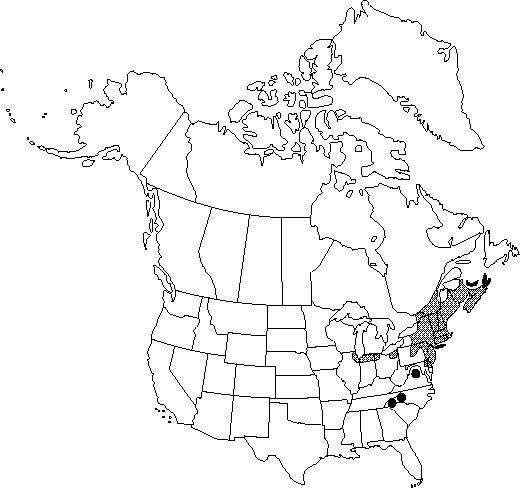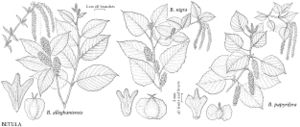Betula populifolia
Arbust. Amer., 19. 1785.
Trees, broadly pyramidal, to 10 m; trunks usually several. Bark when young dark reddish-brown, in maturity becoming grayish white, smooth, close; lenticels dark, horizontally expanded. Twigs without taste and odor of wintergreen, glabrous to sparsely pubescent, dotted with small, inconspicuous, resinous glands. Leaf-blade broadly ovate to deltate or rhombic with 5–18 pairs of lateral-veins, 3–10 × 3–8 cm, base truncate to cuneate, marginally coarsely, irregularly, or sometimes obscurely doubly serrate, apex abruptly long-acuminate; surfaces abaxially glabrous or sparsely pubescent, often covered with minute, resinous glands. Infructescences erect to nearly pendulous, nearly cylindric, 1–2.5 (–3) × 0.8–1 cm, shattering with fruits in early fall; scales adaxially densely pubescent, lobes diverging distal to middle, central lobe cuneate, acute, much shorter than lateral lobes, lateral lobes divergent, broad, irregularly angular. Samaras with wings much broader than body, broadest near middle, often extended beyond body both apically and basally. 2n = 28.
Phenology: Flowering late spring.
Habitat: Rocky or sandy open woods, moist to dryish slopes, old fields, and waste places
Elevation: 100–600 m
Distribution

N.B., N.S., Ont., P.E.I., Que., Conn., Del., Ill., Ind., Maine, Md., Mass., N.H., N.J., N.Y., N.C., Ohio, Pa., R.I., S.C., Vt., Va.
Discussion
Betula populifolia is an important successional tree on burned, cleared, or abandoned land in the Northeast. It is closely related to Betula pendula Roth of Europe, B. neoalaskana of the Northwest, and several Asian taxa. This species is easily distinguished from the paper birch, with which it is often sympatric, by the long tapering apices of its leaves, its nonpeeling bark, and the characteristic expanded, black triangular patches on the trunks below the branches.
The Iroquois used Betula populifolia medicinally to treat bleeding piles, and the Micmac, to treat infected cuts and as an emetic (D. E. Moerman 1986).
The blue birches (Betula ×caerulea Blanchard) have been variously considered to repres species or a hybrid between B. papyrifera Marshall and B. populifolia Marshall (T. C. Brayshaw 1966) or B. papyrifera and the big blue birch B. caerulea-grandis (M. L. Fernald 1922). Both B. ×caerulea and B. caerulea-grandis have been shown in more recent experimental studies to be of hybrid origin between B. cordifolia Regel and B. populifolia (A. G. Guerriero et al. 1970; W. F. Grant and B. K. Thompson 1975; P. E. DeHond and C. S. Campbell 1989). Individuals of these hybrids combine characteristics of the parents, the infructescence scales and leaves somewhat resembling those of B. populifolia, and the habit and exfoliating reddish bark that of B. cordifolia.
Selected References
None.
Lower Taxa
"broad" is not a number."broadest" is not a number. "much broader" is not a number.
